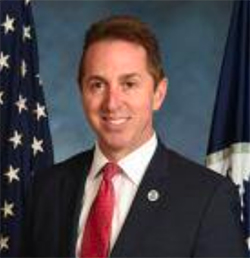
Exclusive
TSA’s move to modern financial system a sign of long-awaited progress for DHS
Troy Edgar, the Homeland Security Department’s chief financial officer, said the Transportation Security Administration moved to the Coast Guard’s financial...
Best listening experience is on Chrome, Firefox or Safari. Subscribe to Federal Drive’s daily audio interviews on Apple Podcasts or PodcastOne.
To say the journey to modernize the Department of Homeland Security’s financial management systems has been full of fits and starts would be an understatement.
The three previous attempts over the last 17 years flopped in public and pronounced ways.
But with the recent move of the Transportation Security Administration to the Coast Guard’s modernized system, the financial management tide may have turned.
Troy Edgar, Homeland Security’s chief financial officer, said the emphasis on business processes and not the technology may finally be why the agency is on the right path to modernize its financial management systems.

“The focus that we’ve had has really been a component-led process and approach, where we really want to try and foster across component perspectives in the decision making, and then at a high level, get perspectives that we can use the unique needs of the businesses and make sure that components aren’t overlooked,” Edgar said in an exclusive interview with Federal News Network. “From our view, the components have a pretty sizable amount of influence over the details of the workflow.”
He said an example of that workflow are accounting classification fields as a way to get standardized business processes.
Edgar said the goal is for all components to implement common business processes regardless of the software product.
“The benefit of taking on this sort of initiative is that you do start to focus on process first. In the shared services industry, outside of the government and in the corporate world, where I’ve focused a lot of my time, you have two choices, you can try to put in a tool first and bring everybody on it, and then force them through the round peg in the square hole, or you can try to get everybody on the same business process. It’s possible to have the same software, but it’s also possible to have a different software. In theory, they will have the same process,” he said.
TSA made transition on Oct. 1
To that end, Edgar said TSA completed its upgrade on the Coast Guard’s system to become the second component to complete the transition to the modern software capabilities. The Countering Weapons of Mass Destruction Office became the first component to use the Coast Guard’s updated system.
Edgar emphasized that TSA and CWMD already were Coast Guard shared-service customers, but using the legacy systems. DHS tried to move to an external shared service provider but decided it wasn’t going to work and pulled out of the project in 2017.
“TSA went live the beginning of October, which means they went through a previous 30-day process before that where they did a transition from old systems maintained by the Coast Guard into the new Oracle system,” he said. “Right now, we’re in the post implementation stabilization [phase]. We’re watching what is happening and we’ve set up different tiers to help us to take on the problems that may occur, which could be training issues, or it could be something significant as data that wasn’t added correctly, or some sort of issue that needed to be evaluated or something as significant as the product is now not working at a scale that it should and needs to be evaluated.”
Under the legacy systems, Edgar said the business processes were not as refined as they needed to be and the data flow was needed to be upgraded.
“I think that a lot of the lift had to do with coming up with the requirements, making sure you can map the requirements into specifications, and then get the specifications, map those into testing, test scripts, both through system integration and user,” he said. “For TSA, specifically, you get a project team that’s made up of great internal DHS people that have been assigned to this and really good vendors, but the rubber meets the road, about 8-to-12 weeks prior to going live, when you really start to turn the system over to the users to ‘have it accepted.’ And through that process, you start training people up on the new system.”
About 200 users initially used the system, but that number soon increased to 1,400 when the system went live in October.
Second component to use Coast Guard
The reason why TSA moving to the Coast Guard’s system is such a big deal, Edgar said, is the size of the agency. TSA has a budget of $8.7 billion and a user base of more than 13,000.
“I think the process that we went through and the approach was to first bring on something small, get it to scale, bring on the next thing, TSA,” Edgar said. “For TSA, there are a lot of advantages, including, obviously, the business process efficiencies that they’ll gain and getting to a common accounting line.”
Edgar said over the short to medium term, TSA will have a common data model, which will lead to more efficient reporting and then open the door wider for data analytics and robotics process automation (RPA).
“My vision for TSA, once they’re stable and they’re in a normal production mode, is we’ll start adding enhancement processes on top of it, that would be on reporting, and then eventually RPA,” he said.
Edgar said DHS continues to pursue its other path to modernize financial management systems at FEMA or the U.S. Immigration and Customs Enforcement directorate.
DHS released two solicitations in November 2019 to buy software and integration services. While Edgar couldn’t comment on the status of that effort because it’s in procurement evaluations and facing challenges in federal court, he did say the longer term goal is for the systems to share data seamlessly, and possibly move to one application across all of the agency.
Edgar said the next step is to move the Coast Guard onto the modern financial management system by October.
Copyright © 2024 Federal News Network. All rights reserved. This website is not intended for users located within the European Economic Area.
Jason Miller is executive editor of Federal News Network and directs news coverage on the people, policy and programs of the federal government.
Follow @jmillerWFED





